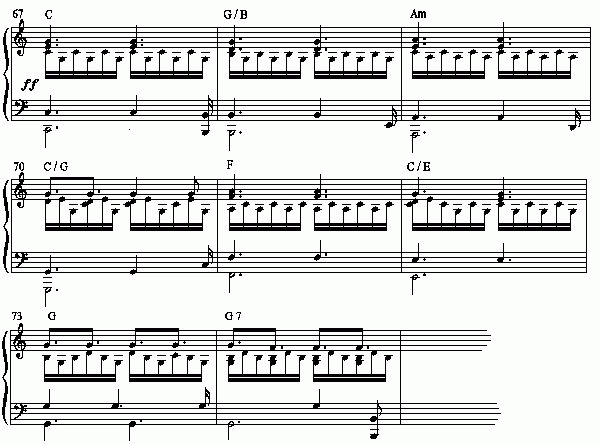It's Me That You Need is a rarely heard early
single put out by Elton and Bernie. It was released as a
single in May 1969 in the UK and as the B-side to a re-release
of Lady Samantha in January 1970 in the US. Elton kept it
in his live set at least through 1971.
This version is taken from a bootleg of his first performance
in Tokyo Japan, October 11, 1971. I've included the mp3 for
your reference purposes. Elton had already begun his conquest
of the US by the time of this concert and was preparing to
unleash a string of hits that would make him an international
star.
Elton's Mozart Style
What I like about this song is that it is the earliest example I've heard of
the Elton John ballad style of piano playing. It's a style that he employed
significantly in the Elton John album, which came out a year later. This
is not a great song, not a bad one either, but the elements of his playing
style are present and that's what I'm excited about.
For discussion purposes, I've nicknamed this style of playing
as Elton's “Mozart” style. It's a style of playing
where the right hand plays broken arpeggios in a manner similar
to the left hand accompaniment that Mozart used in his signature
pieces (also known as the alberti
bass style). By itself,
this style is a simple and effective approach to accompaniment
that
a beginning
pianist
could
employ.
But of course the pure Mozart style would be boring if wasn't
for Elton's ability to mix up the basic repetitive arpeggiation
with different arpeggio patterns, passing notes, riffs and
rhythmic syncopations. Combined with his articulation, these
devices provide lots of subtle and fascinating shifts of
emphasis that percolate beneath the melody of the song.
Starting with the opening bars, you can see how well Elton
mixes it up. An important part of Elton's technique involves
holding notes with the 5th finger of the left and right hands
while the inner fingers do the work. Notice how he changes
the accents from bar to bar with his lead notes.

The song is in 6/8 which is a nice change from a standard
4/4 time and provides a "1-and-a-2-and-a" or tuplet feel to the rhythm.
This is not an ambitious song. Harmonically it uses a descending
bassline or diatonic approach to chord changes. It’s
in the key of C; the verses center on the relative minor
of Am with the chorus shifting to C. The song structure is
in 8. After 2 8-bar verses, there is an 8-bar pre-chorus.
|| Am - Am - G - G - F - C/E - G - G || 2 times
|| F - C/E - G - C - F - C - G - G ||
The chorus also uses an 8-bar descending bassline harmony
as shown in the following example.

Simple and compelling, I find this song to be of historic
interest. I hope you enjoy it as well.
|

